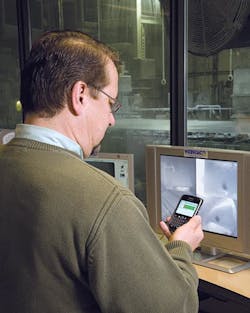Cellular communications can make it simpler for executives and plant managers to see what’s going on in their facilities.
One of the most obvious reasons for employing cellular is to access really remote operations. For example, Meurer Research Inc. makes water treatment systems sold around the globe. It is now ramping up production of a diagnostic feature that provides access to isolated water treatment plants using a Sierra Wireless AirLink cellular modem provided by its key equipment provider, Milwaukee-based Rockwell Automation Inc. That gives Meurer real-time insight into how new facilities are working.
“In the past, we’d install a system and we’d only hear from people when there were problems,” says Don Bersell, project manager at Golden, Colo.-based Meurer. He notes that Meurer has deployed cellular in a few pilot plants and is now including it in production installations.Integrator access
Makers of all types of industrial equipment are using wireless to gather diagnostic data and keep their machines running in the field. That can be a more direct path for outsiders, including system integrators, to access the systems they need to monitor and troubleshoot.
“If you use a cellular router, you can go directly through the air to the manufacturing site,” says Scott Killian, worldwide director of presales solutions at Sixnet, a Ballston Lake, N.Y., provider of cellular routers. “An outside contractor can get access without all the effort of getting the IT (information technology) department to give them access to the corporate network.”
These links also help keep plants running closer to full capacity. Executives at Mohawk Fine Papers Inc. use cell phones to monitor ordering and production data for their specialty papers, which are produced in fairly small runs on equipment that fills huge buildings. Executives and key managers can look at cell phones to see data critical to them, getting real-time information from anywhere.
“The mobility aspect is truly important, we can’t be successful unless we’re always watching to see how the business is running,” says Paul Stamas, vice president of information technology for Cohoes, N.Y.-based Mohawk. “Orders flow very fast, we’re acquiring a lot of information and we need to respond quickly. Shop information has to be tied to customer information.”
Using software from Transpara, based in Pleasanton, Calif., Mohawk executives are always watching the parameters they select themselves. These specifications, which Transpara calls key performance indicators (KPIs), can be set to any threshold. On the cell phone, they’re typically displayed with red, green and yellow bars to show alarms, warnings or all systems go.
“When something is not running well, we can move the mouse down to expand areas that show red. In a matter of five to 10 seconds, you can focus in and know exactly what’s wrong,” Stamas says.Cut travel time
This ability to monitor performance is a universal benefit of remote access. Many users say it can improve quality of life for those entrusted with keeping facilities running day and night. It’s much quicker for a plant manager to monitor a system from home and make changes than to drive into the factory to flip a switch or two. Eliminating travel time is even more important for equipment makers who have to troubleshoot products in the field. That’s especially true for a global company such as Meurer, as even fairly nearby water treatment facilities are often difficult to reach.
“We’re saving a lot of travel time and getting things done more quickly,” Bersell says. “We can look in and see if a drive needs to be reset. We can also go in to make adjustments, changing from 12 rpm (revolutions per minute) to five.”
Proponents note that cellular links can also reach into areas where only very low bandwidth networks are used to poll data from remote sensors. Satellite communications can easily reach areas that aren’t accessible by Wi-Fi (Wireless Fidelity).
“Normally, adjusting something like a sensor in a smokestack is a two-man job, one to go up to adjust the sensor and one to watch the monitors and provide feedback,” says Michael Saucier, chief executive officer of Transpara. “Now, you can climb up and change a setting, then see how it looks on your iPhone.”
Cell phone access can also make it easier for technically savvy executives to monitor systems. “This also makes it easier for hands-on executives to keep their finger on the pulse of the company,” Saucier says. “They can pick any parameters they want to see, historical, current, comparative.”Related Feature - World Without WiresTo read the feature article relating to this story, go towww.automationworld.com/feature-7027.
Companies in this Article
Companies in this Article
Leaders relevant to this article:

